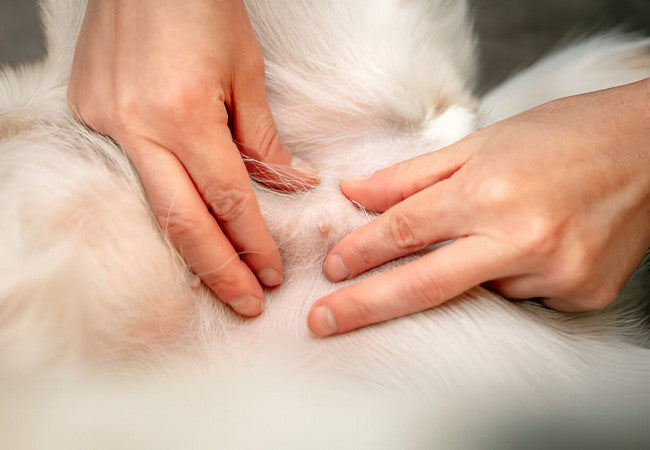Vet’s 2025 Guide to Canine Mammary Gland Tumors 🩺🐾

In this article
Vet’s 2025 Guide to Canine Mammary Gland Tumors 🩺🐾
By Dr. Duncan Houston BVSc
Mammary gland tumors are the most common tumors in unspayed female dogs, ranging from benign growths to highly aggressive carcinomas, sarcomas, or inflammatory cancers. This comprehensive 2025 guide covers causes, clinical signs, staging, diagnosis, treatment, prognosis, and preventive care—integrating modern clinic insights with at-home support via Ask A Vet. 🐶✨
1️⃣ What Are Mammary Tumors?
These are neoplasms arising from mammary tissue along the dog’s ventral abdomen and chest. Benign forms (adenomas, fibroadenomas) and malignant tumors (carcinomas, sarcomas, carcinosarcomas) occur; approximately 50% are malignant.
2️⃣ Who Is at Risk & Why?
- Hormonal influence. Intact females face a seven-fold higher risk; spaying before the first heat reduces risk to.
- Age & breed Most cases occur at 7–11 years; predisposed breeds include Chihuahuas, Poodles, Cocker Spaniels, English Setters, Boston Terriers.
- Lifestyle factors, Obesity, and early-life red-meat diets may increase risk.
3️⃣ Recognizing Signs Early
- Painless lumps along the mammary chain—firm or mobile.
- Tender, ulcerated masses; possible nipple discharge.
- Ulcers, warmth, weight loss, lethargy, coughing, and if metastasis is present.
4️⃣ Diagnosis & Staging (TNM System)
- Physical exam with mass measurement and palpation of draining lymph nodes.
- FNA of nodes and fine‑needle aspiration/biopsy of the mass to differentiate benign vs malignant.
- Imaging (chest X‑ray, abdominal ultrasound) to detect metastasis.
- TNM stages Tumor size T1 <3 cm, T2 3–5 cm, T3 >5 cm; N involves lymph nodes; M indicates distant spread}.
5️⃣ Treatment Options
✂️ Surgery—Primary Treatment
- Lumpectomy or mastectomy types (simple, regional, radical, bilateral) are based on the number and location of masses.
- Ensure wide margins and removal of involved lymph nodes for malignancies.
- Spaying concurrent with surgery reduces recurrence and may prolong survival.
🧬 Chemotherapy & Radiation
- Malignant or high-grade tumors may receive chemo; radiation is used for local.
- Protocol choice is driven by histologic type, metastasis, and tumor grade.
6️⃣ Prognosis & Survival
- Benign tumors excellent outcome—no spread is expected after surgical removal.
- Malignant carcinomas 50% remain localized—surgery offers good control; metastasis typically occurs in lymph nodes and lungs within 1–2 years.
- Histologic factors—size >5 cm, lymph node involvement (Stage IV), or metastasis (Stage V)—are associated with poorer survival (90 days for Stage IV).
- Tumor type simple carcinomas fare better (~2 years) versus sarcomas and carcinosarcomas (~9–12 months); inflammatory carcinoma carries a largely grave outlook.
- Collagen biomarkers and digital histopathology are emerging prognostic tools.
7️⃣ Follow-Up & Monitoring
- Chest X-ray/abdominal scans every 3–6 months post-surgery to detect recurrence.
- Self-check mammary chain during routine wellness exams; palpate lymph nodes weekly during the recovery period.
- Discuss periodic histology revision or molecular testing with your vet for tailored care.
8️⃣ Preventive Care
- Spaying before the first heat cycle dramatically lowers risk, and continues to provide benefits even later into life.
- Maintain a lean body condition to reduce lifelong cancer risk.
- Manage diet—limit red meat and high-fat homemade feeding.
- Monthly home exams for early detection; consult a vet for any new lumps or skin changes.
9️⃣ Supportive Care & Brand Integration
- Ask A Vet telehealth guidance for wound care, chemo side effects, and recovery progress.
🔟 When to Contact Your Vet
- New or enlarging lumps in the mammary area or lymph nodes.
- Persistent ulceration, bleeding, or discharge from a mass.
- Lethargy, weight loss, coughing, or breathing changes post-diagnosis.
- Side effects from treatments—swelling, vomiting, or appetite loss.
🏁 Final Thoughts
Mammary gland tumors, though common in unspayed female dogs, are manageable, especially with early detection, surgical intervention, and appropriate post-treatment care. Advances in staging, pathology, and telehealth support through Ask A Vet, combined with recovery tools. With proactive prevention and monitoring, many dogs enjoy long and happy lives. 🐾❤️
Need help planning surgery, managing recovery, or wellness follow-up? Visit AskAVet.com and download the Ask A Vet app—because your pet deserves trusted support every step of the way. 📱🐶






